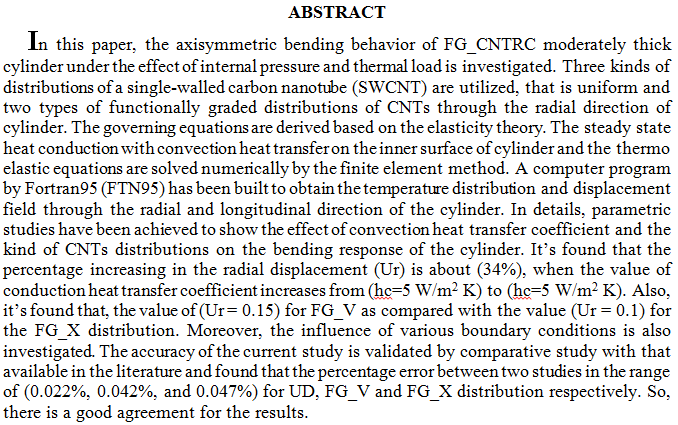
A partial temporary immunity SIR epidemic model involv nonlinear treatment rate is proposed and studied. The basic reproduction number is determined. The local and global stability of all equilibria of the model are analyzed. The conditions for occurrence of local bifurcation in the proposed epidemic model are established. Finally, numerical simulation is used to confirm our obtained analytical results and specify the control set of parameters that affect the dynamics of the model.
 (10)
(10)
 (4)
(4)
 (1)
(1)
The wake potential and wake phenomena for swift proton in an amorphous carbon target were studied by utilising various dielectric function formalisms, including the Drude dielectric function, the Drude–Lorentz dielectric function and quantum dielectric function. The Drude model results exhibited a damped oscillatory behaviour in the longitudinal direction behind the projectile; the pattern of these oscillations decreases exponentially in the transverse direction. In addition, the wake potential extends slightly ahead of the projectile which also depends on the proton coordinate and velocity. The effect of electron binding on the wake potential, characterised by the ratio to 0.1, has been studied alongside the Drude–Lorentz dielectric
... Show More (7)
(7)
 (6)
(6)
The thermal method was used to produce silicoaluminophosphate (SAPO-11) with different amounts of carbon nanotubes (CNT). XRD, nitrogen adsorption-desorption, SEM, AFM, and FTIR were used to characterize the prepared catalyst. It was discovered that adding CNT increased the crystallinity of the synthesize SAPO-11 at all the temperatures which studied, wile the maximum surface area was 179.54 m2/g obtained at 190°C with 7.5 percent of CNT with a pore volume of 0.317 cm3/g ,and with nano-particles with average particle diameter of 24.8 nm, while the final molar composition of the prepared SAPO-11 was (Al2O3:0.93P2O5:0.414SiO2).
 (1)
(1)
There are no single materials which can withstand all the extreme operating conditions in modern technology. Protection of the metals from hostile environments has therefore become a technical and economic necessity.
In this work, for enhancing their wear-resistance, boride layers were deposited on the surface of low carbon steel by a pack cementation method at 850 °C for (2, 4, and 6) h using vacuum furnace. The boronizing process was achieved using different concentration of boron source (20, 25, and 30) % wt. into coating mixture to optimize the best conditions which ensure the higher properties with lower time. The coating was characteristic by X ray diffraction (XRD), and it is confirmed t
... Show MoreActivated carbon was Produced from coconut shell and was used for removing sulfate from industrial waste water in batch Processes. The influence of various parameter were studied such as pH (4.5 – 9.) , agitation time (0 – 120)min and adsorbent dose (2 – 10) gm.
The Langmuir and frandlich adsorption capacity models were been investigated where showed there are fitting with langmmuir model with squre regression value ( 0.76). The percent of removal of sulfate (22% - 38%) at (PH=7) in the isotherm experiment increased with adsorbent mass increasing. The maximum removal value of sulfate at different pH experiments is (43%) at pH=7.
 (16)
(16)
 (10)
(10)
 (39)
(39)
 (38)
(38)
New microphotometer was constructed in our Laboratory Which deals with the determination of Molybdenum (VI) through its Catalysis effect on Hydrogen peroxide and potasum iodide Reaction in acid medium H2SO4 0.01 mM. Linearity of 97.3% for the range 5- 100 ppm. The repeatability of result was better than 0.8 % 0.5 ppm was obtanined as L.U. (The method applied for the determination of Molybdenum (VI) in medicinal Sample (centrum). The determination was compared well with the developed method the conventional method.
Nano gamma alumina was prepared by double hydrolysis process using aluminum nitrate nano hydrate and sodium aluminate as an aluminum source, hydroxyle poly acid and CTAB (cetyltrimethylammonium bromide) as templates. Different crystallization temperatures (120, 140, 160, and 180) 0C and calcinations temperatures (500, 550, 600, and 650) 0C were applied. All the batches were prepared at PH equals to 9. XRD diffraction technique and infrared Fourier transform spectroscopy were used to investigate the phase formation and the optical properties of the nano gamma alumina. N2 adsorption-desorption (BET) was used to measure the surface area and pore volume of the prepared nano alumina, the particle size and the
... Show More